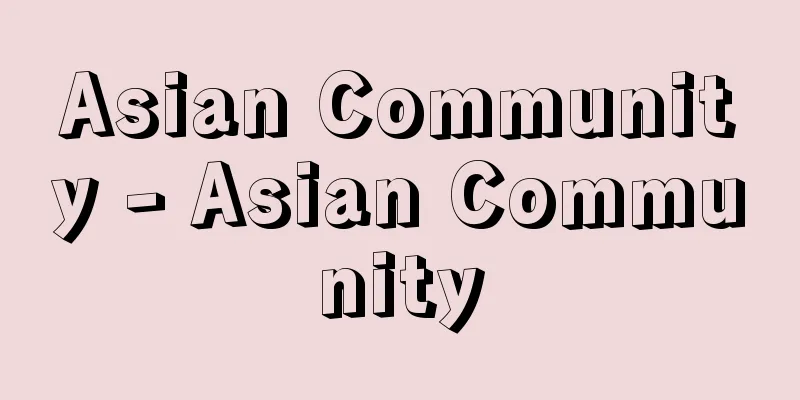Asian Community - Asian Community

|
A community that is said to have been the basis of old Asian societies before they were colonized or semi-colonized by European powers. In "Forms Antecedent to Capitalist Production" (draft of "Grundrisse", 1857-1858), Marx characterized Asian communities in comparison with classical ancient communities and Germanic communities. In "Capital" (Chapter 12, Part 1), using India as the direct subject, he states that Asian communities consist of three elements: (1) common ownership of land, (2) domestic union of agriculture and handicrafts, and (3) fixed caste-based division of labor. Moreover, Asian societies are characterized by the fact that these Asian communities are isolated from one another and scattered like countless atoms, and that Asian despotic states stand tall. This image of old Asian societies was shared not only by Marx but also by most 19th century European thought. It is also commonly accepted in Japan today through works such as Hisao Otsuka's "The Fundamental Theory of Community" (1955). However, in recent years, with the development of historical and anthropological research on Asian and African societies, it has become clear that this image of old Asian societies is far removed from the reality of Asian societies, and is rather rooted in European prejudices against Asia. The theory of Asian communities is being forced to undergo a fundamental reexamination, including the question of whether the very concept of an Asian community is even possible. [Otani Hiroyuki] "Marx and Asia" by Hiroyuki Kotani (1979, Aoki Shoten) " "Community and Modernity" by Hiroyuki Kotani (1982, Aoki Shoten) [References] | | |Source: Shogakukan Encyclopedia Nipponica About Encyclopedia Nipponica Information | Legend |
|
ヨーロッパ列強によって植民地あるいは半植民地とされる以前の旧アジア社会の基礎をなしていたとされる共同体。マルクスは「資本制生産に先行する諸形態」(草稿『経済学批判要綱』1857~1858)で、古典古代的共同体、ゲルマン的共同体との対比においてアジア的共同体を特徴づけた。『資本論』(第1部第12章)では、インドを直接の素材として、アジア的共同体が、(1)土地の共有、(2)農業と手工業との家内的結合、(3)固定されたカースト的分業、の三つの要素からなるとされている。そして、このアジア的共同体が相互に孤立したまま、無数の原子のように散在しているうえに、アジア的専制国家が聳立(しょうりつ)しているのがアジア社会の特徴とされた。このような旧アジア社会のイメージは、マルクスのみならず、19世紀ヨーロッパ思想にほぼ共通するものであった。それは今日の日本においても、大塚久雄の『共同体の基礎理論』(1955)などを通して一般に受け入れられている。しかし、近年、アジアやアフリカの社会についての歴史学的、人類学的研究の発展によって、このような旧アジア社会のイメージが、実体としてのアジア社会のあり方からはほど遠いものであり、むしろヨーロッパ人のアジアに対する偏見に多く根ざすものであることが明らかになった。アジア的共同体という概念そのものが成立しうるものなのかという問題を含めて、アジア的共同体論は根本的な再検討を迫られている。 [小谷汪之] 『小谷汪之著『マルクスとアジア』(1979・青木書店)』▽『小谷汪之著『共同体と近代』(1982・青木書店)』 [参照項目] | | |出典 小学館 日本大百科全書(ニッポニカ)日本大百科全書(ニッポニカ)について 情報 | 凡例 |
>>: Asian Horned Frogs - Asian Horned Frogs
Recommend
Railroad tracks
〘noun〙① A line that goes straight in a certain dir...
Jean Brunhes
1869‐1930 French geographer. He studied under Vida...
Oligomenorrhea - Oligomenorrhea
...Menopause before age 40 is called early menopa...
Kingdom of Lydia
An ancient kingdom in western Asia Minor. Its capi...
Undersea Battleship
A series of adventure novels representative of Osh...
Hosho - Hosho
A document issued by a vassal to convey the will ...
Prince Furuhito no Oe - Prince Furuhito no Oe
[raw]? [Died] Taika 1 (645). Yoshino? A prince of ...
bien parado (English spelling) bienparado
...The dance often involves a mixture of rhythms ...
Traveling merchant - Gyoshonin
Bosch painting, " De marskramer ", origi...
Tribune - tribunus plebis (Latin)
The leader of the plebeians in ancient Rome, late...
European plum
… [Isao Shimura]. … *Some of the terminology expl...
Al-Maqrizī, Abū al-`Abbās Aḥmad ibn `Alī Taqī al-Dīn
[Born] 1364. Cairo Died: February 9, 1442. Arab hi...
Bromide - bromide
Photographic paper made from silver bromide, and ...
Platalea minor (English spelling)
… [Hiroyuki Morioka]. … *Some of the terms that m...
Cassandros
He was one of the Diadochi who fought over the he...









